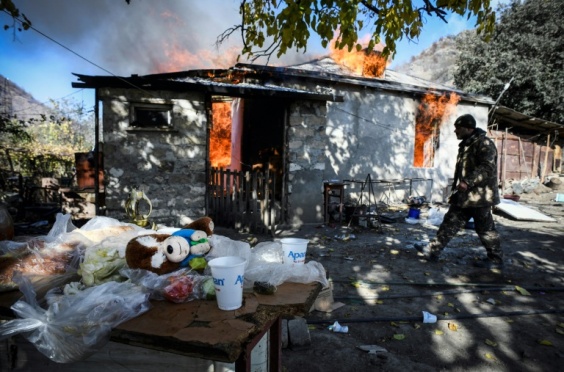Armenian villagers burn houses ahead of Azerbaijan takeover
CHAREKTAR – Villagers outside of Nagorno-Karabakh set their homes on fire Saturday (14) before fleeing to Armenia ahead of a weekend deadline that will see some disputed territory handed over to Azerbaijan as part of a peace agreement.
Residents of the Kalbajar district in Azerbaijan, which has been controlled by Armenian separatists for decades, began a mass exodus this week after it was announced that Azerbaijan would regain control on Sunday (15).
Fighting between the separatists backed by Armenian troops and the Azerbaijan army erupted over the breakaway Nagorno-Karabakh region in late September and raged for six weeks.
Armenia said Saturday that 2,317 of its fighters were killed in the clashes, an increase of nearly 1,000 deaths from its previous official toll.
Azerbaijan has not revealed its military casualties.
But Russian President Vladimir Putin said Friday (13) the number killed in the conflict was higher than 4,000 and that tens of thousands of people had been forced to flee their homes.
In the Kalbajar village of Charektar, on the border with the district of Martakert which will remain under Armenian control, at least six houses were on fire Saturday morning, with thick plumes of smoke rising over the valley, an AFP journalist saw.
“This is my house, I can’t leave it to the Turks,” as Azerbaijanis are often called by Armenians, one resident said as he threw burning wooden planks and rags soaked in gasoline into an empty house.
“Everybody is going to burn down their house today… We were given until midnight to leave,” he said.
“We also moved our parents’ graves, the Azerbaijanis will take great pleasure in desecrating our graves. It’s unbearable.”
On Friday at least 10 houses were burned in and around Charektar.
Kalbajar was almost exclusively populated by ethnic Azerbaijanis before they were expelled by Armenians in a 1990s war between the two countries following the break up of the Soviet Union, and a majority of the homes being burned previously belonged to Azerbaijanis.
Armenia’s government controversially subsidised the region’s settlement by ethnic Armenians.
The ex-Soviet rivals agreed to end hostilities earlier this week after previous efforts by Russia, France and the United States to get a ceasefire fell through.
A key part of the peace deal includes Armenia returning Kalbajar and the Aghdam district by November 20, as well as the Lachin district by December 1, all of which have been held by Armenians since the devastating 1990s war left 30,000 people dead.
After weeks of intense fighting, the two sides will maintain positions in the territories they currently hold — a significant gain for Azerbaijan, which has reclaimed around 15 to 20 percent of its lost territory including the key town of Shusha.
Russian peacekeepers began deploying to Nagorno-Karabakh on Wednesday as part of the terms of the accord and took control of a key transport artery connecting Armenia to the disputed territory.
Russian military officials said the mission consisting of nearly 2,000 troops would put in place 16 observation posts in mountainous Nagorno-Karabakh and along the Lachin corridor.
Azerbaijani President Ilham Aliyev has accused Armenians of destroying “99 percent of the liberated territory” including hospitals, houses and monuments, adding that he wants Armenia to pay compensation.
Meanwhile in Armenia, anger has been mounting over Prime Minister Nikol Pashinyan’s decision to cede swathes of territory.
The former head of Armenia’s national security service, Artur Vanetsyan, was arrested on Saturday on charges of plotting to kill Pashinyan and seize power.
Vanetsyan’s lawyers described the arrest as a “shameful persecution of opponents”.
Thousands of people converged on the streets of the capital Yerevan in demonstrations this week, while protesters stormed and ransacked government buildings, demanding Pashinyan’s resignation.
On Saturday, crowds gathered on Yerevan’s Liberty Square, where they lit candles in memory of soldiers killed in the fighting.
They then marched silently through the streets towards the Matenadaran museum of ancient manuscripts where priests held a requiem service.
-Agence France-Presse


